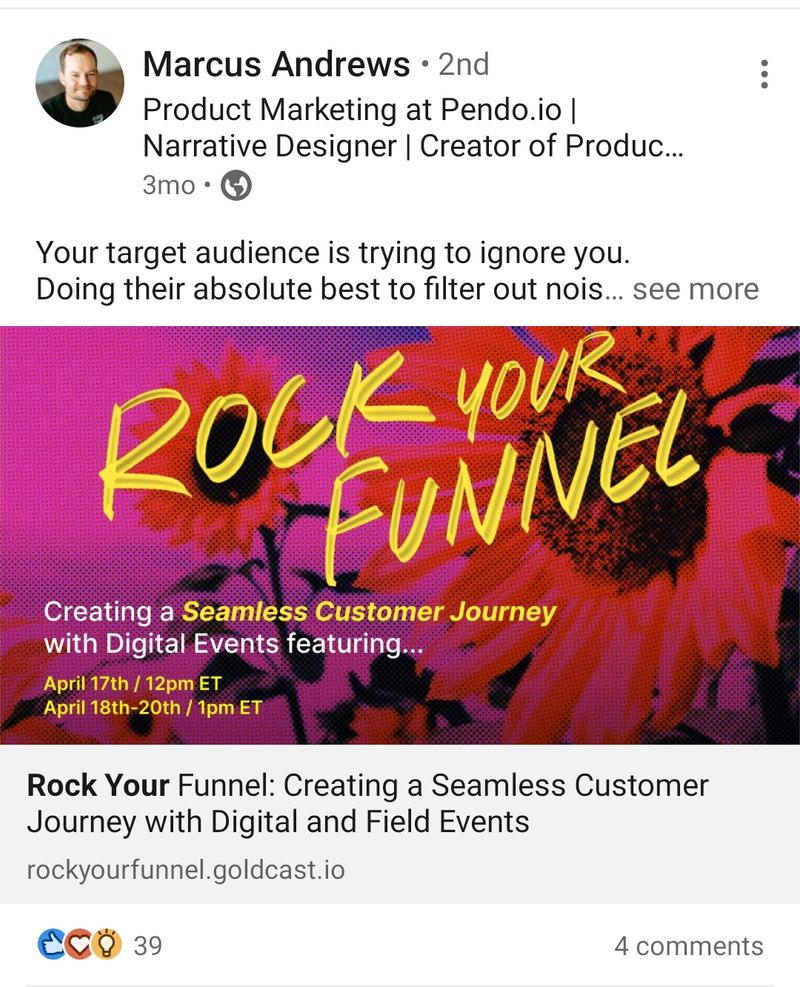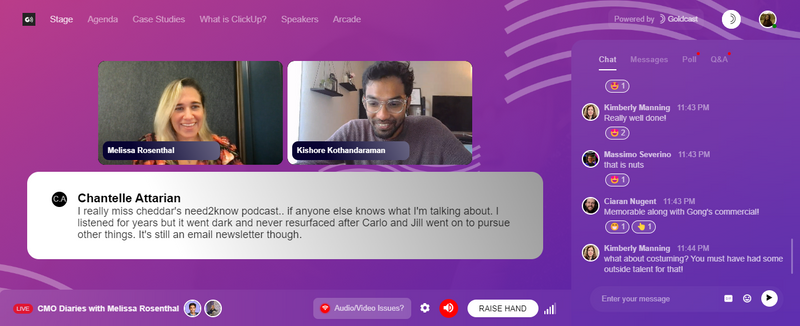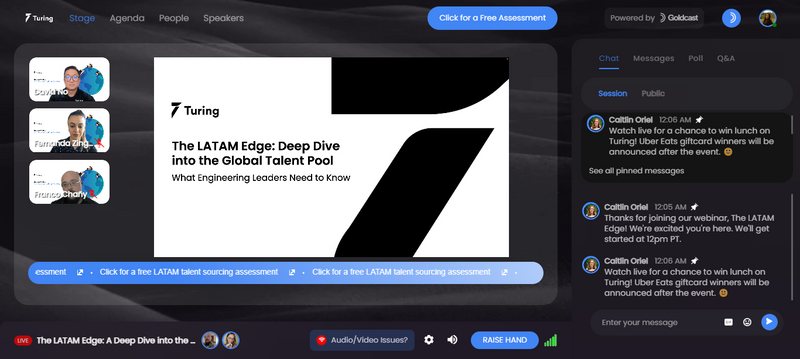Start Strong and Finish with Flair: The Goldcast Guide to Webinar Management

Maximize Your Marketing ROI
Join 10,000 other marketers already getting the best tips on running engaging events that boost pipeline and create raving fans.
For a marketer, nothing could be worse than having an audience who's excited to hear your message and fumbling your chance to engage them. And, in the world of webinars, strong webinar management is the key to prevent this from happening!
Being thoughtful before, during, and after your live event can really set the stage for a successful webinar and keep your audience coming back for more. Ideally, your planning will create a flawless flow that hooks people the second they see the event landing page and keeps their attention until well after the event.
To do that, you'll need to spend time planning for and promoting your webinar, sprinkle in engagement touchpoints throughout the actual event, and craft a post-event follow-up plan long before the event kickoff.
Today, we'll talk about all of that and more!
In this ultimate guide, you'll learn:
- Before your webinar: Brainstorming, branding, and more
- During your webinar: Engagement is the name of the game
- After your webinar: Follow-up time
Before we start, have you downloaded our webinar planning checklist yet? This is a must-have for effective webinars! You can use it to take care of any technical to-dos and ensure you don't run into any surprises during your event.
Make planning your next event a breeze by downloading the full version below and adding notes to it, based on what you learn here!
DOWNLOAD THE WEBINAR PLANNING CHECKLIST
Before your webinar: Brainstorming, branding, and more
While the live webinar is the big moment you're moving toward, the bulk of the webinar marketing work actually happens before the event. Here are the major tasks you'll want to take care of before event day.
Iron out the details of what your webinar's about
Before you do anything, think about the larger landscape the webinar will live within. How does it play a role in your overall integrated marketing campaign?
If you're not familiar with integrated campaigns, that’s ok! Here’s the Tl;dr: In a nutshell, we recommend thinking about webinars as the "lightning bolt" moment that lives between your initial promotional efforts and everything you'll do after.
In order to create meaningful events, ask yourself these questions:
- Why this webinar topic? In other words, what value does this subject provide to your audience? Why will people feel motivated to attend? Why is your presenter the best person to talk about it?
- Who is my target audience? Who are the ideal customer personas (ICPs) who would sign up for this event? This will largely dictate the direction your content planning takes. For example, you'd have a very different presentation for decision-makers within a company versus the end users who will be in the product day to day.
- Why now? What is your reason for organizing this event right now? Is this tied to a specific product launch? Have you received feedback from customers that they want to hear more on this topic? Or is there another reason?
- What other related topics might we pull in? Could this potentially become a series or recurring event?
- Should I partner with anyone else for this event? While adding partners to the mix can complicate things a little, sometimes it's well worth it! Partners can help you expand your audience, boost your promotion signals, and enhance your credibility in the industry. You might invite people in to be a guest speaker, act as a moderator, participate in panel discussions, or choose a different webinar format. Just make sure you're clear about who owns what!
- What are the goals or KPIs tied to this event? Being clear about what you hope to achieve with your free webinar can help you track ROI afterward. (PS: Tracking ROI for events has always been a challenge. Check out our new Event Analytics dashboard for crystal-clear ROI reporting!)
Once you've got the main idea behind your webinar ironed out, it's time to start executing on it!

Branding time
As you set up your webinar registration in your event platform and prepare to promote the event, your next big task is branding.
As strange as it may sound to newbie marketers, branding for your event starts well in advance of welcoming attendees to the webinar itself. In fact, branding starts the second a person opens an email from you, sees one of your social media ads, or clicks on your event landing page!
Some ideas here:
- Use event or series hashtags to create momentum and a feel of exclusivity around a specific event or topic. When done right, hashtags can help you reach more people and people can use them during the event to keep the conversation going!
- Take a look at every potential touchpoint and make sure that it's true to your brand. Goldcast allows you to customize every inch of the customer journey so that your events feel true to you and speak directly to your audience.
- The slide deck or PowerPoint for your event should be 100% on brand with your landing page and other promotional materials! It would be jarring for attendees to arrive expecting a certain feel and see something totally different when the presentation kicks off.
- Are you giving away swag or promotional materials for or during your event? If so, do you need to have those branded in a specific way?
- As you're creating assets for your event, think about ways you can create templates out of things to make your job easier in the future! The goal is always to work smarter, not harder.
Promote your event
Here, you'll craft your plan for promoting the event. If you've involved a partner, you'll want to think about what assets they might need from you to spread the word as well. Remember that one of the major benefits of partnering with someone is growing your potential audience, so you definitely want to make it easy for them to let people know about the event!
If you had a productive branding phase, you've probably got most of your stuff ready to go. You have your on-brand registration page, email banners, social media posts, and more—so, what do you do with them now?
Well, to put it simply, you need to get the material in front of the people you want to attend. You can do that through email campaigns, though you should avoid blanket promotions and only target the most relevant audience. The last thing you want is people unsubscribing because they're receiving email promotions for an event they'd never attend!
Though email sequences can take a bit of forethought, don't let that deter you. Email is often the highest converting channel for driving registrations, and it's critical to take advantage of that.
You should also think about where your audience hangs out the most. If that's on LinkedIn—like our Goldcast audience is—then consider paid or organic posts on that channel! If it's on Instagram, post there instead. Or perhaps your people are in other niche online communities—or even in your app, where you can surprise them with in-app messages. That's fine, too.


Wherever your audience is, is where you want your messaging to be.
Finally, your sales and success teams should also be using this time to reach out to prospects with personalized promotions and help move people along their individual customer journeys.
📈Skyrocket webinar registrations with these webinar promotion tips.
Plan now for what happens after the event
It may sound counterintuitive, but before the event is the best time to map out what will happen afterward. People expect to hear from you after they attend your event, and right after the webinar may be a valuable time to close the deal.
At a minimum, set up a segmented email sequence with different messaging based on who attended and who didn't. Your emails should provide everyone with the on-demand event recording and any other information or resources you want them to have. Bonus points for taking segmentation further here and getting hyper-personalized with the messaging!
Consider whether you want your sales team to perform 1:1 outreach for certain high-intent or high-value accounts. Now's the time to prep sales snippets, webinar takeaways, recap notes, and anything else that will help your sales folks get their jobs done.
That way, after the event, when you send your sales team engagement-related activity (for example, who was most engaged during the event), they'll understand how to use it for lead generation or nurturing purposes. They'll have the full picture they need to reach out and make meaningful contact.
Get everyone on the same page
You're almost done with the prep work! Now, double check that your event is on the internal events calendar and that everyone on the team knows about it. You don't want anything getting scheduled during the same time frame as your webinar!
This is also the time to do any necessary backend tasks. Connect your webinar platform to your marketing automation system, make sure all relevant connections are working, and set up any workflows you'll use.
Do a full runthrough of the event
You will, of course, need to sketch out the timeline of your webinar so that speakers and hosts know their cues. And, whenever possible, you should also try and do a runthrough of the webinar ahead of time.
This can help you spot any glaring issues with flow or content, think of the right timing for engagement touchpoints, and identify any technical issues with your platform or internet connection before you're in front of a live audience.

During your webinar: Engagement is the name of the game
Once it's show time, your main focus is going to be on engagement—and that applies to both creating and tracking it.
Not only is tracking engagement metrics a good way to see how interested people were during your event, but it's also a great indication to your sales team about who the hottest leads are!
Here's a list of features that foster engagement:
- Chat: Start the session with an icebreaker, and encourage folks to drop in questions as the event progresses. With Goldcast, you can pull questions from the chat on stage to highlight them and allow speakers to answer them on the spot. You can also pin important messages from the chat so that no one misses them.

- Polls: Polls can also be a good way to start a session; asking a question about everyone's current state or their goals in attending the event can help get everyone on the same page. Sometimes, polls even steer the conversation in new directions. You can also use polls for fun trivia moments to give everyone a learning break!
- Q&A: At this point, it's generally expected that you offer a dedicated Q&A session, often at the end of your event. At Goldcast, we usually have a slide deck and presenter combo going for the first half hour, and then we transition into Q&A so we can dive deeper with the audience. You could also ramp it up with video Q&A, where you invite someone from the audience "on stage" during the event to ask their question live!
- Resources or Documents tab: This is a section within your event platform that includes links or copies of relevant resources and documents. People can navigate to the tab during the event to find out more about specific topics.
- Booths, apps, and games: When we use embedded apps at our Goldcast events, we see engagement skyrocket, which makes us want to keep doing it! If you've got anything like an in-event game or vendor booths that you want people to check out, be sure to let them know at the start of the event so they can spend time exploring.
- Lower thirds: If you watch the news, you know what this is! A lower third is a graphic that shows up on the bottom third of your screen and draws your attention to the content there. In Goldcast, you can use lower thirds to offer speaker info, additional tips about what's being discussed, and more.

When hosting webinars, stick to your Run of Show, but be flexible. Things happen, and you should be able to roll with the punches if something goes off course! If a presentation or specific conversation takes longer than expected, pivot in real time to subtract time from a different segment of the event so that things still run on time.
After your webinar: Follow-up time
Once your webinar presentation wraps, it's time to close the loop on all fronts!
First, make sure your virtual events are available in a high-quality, on-demand format for people to watch. You can provide access to on-demand webinars in a number of ways:
- Provide a link to re-enter the event experience, and people can watch on demand from there. This can be fully automated, or you can export, edit, and re-upload your video if you have some tweaks to make.
- Export and add to YouTube.
- Export and upload to a video player or library on your website.
- Use your event platform to upload it into a branded and interactive event hub.
Next, send out those follow-up emails! Make sure everyone has the on-demand link and let them know where they can find other information or learn more about your company. Be sure that your call to action (CTA) is clear and people know exactly what you want them to do.
Double-check to see if all data has been updated in your MAP and CRM integrations. Once you've got the green light there, share all relevant info with your sales team so they can start personalized outreach.
Finally, it's time to think about how to repurpose the content from your webinar. Maybe you choose to spin up a compelling infographic about some stats you discussed in your event, or perhaps you use discussion points to start a buzzworthy conversation on social media. Or maybe you want to turn some of the topics into SEO-driven blog posts to drive traffic to your site.
Whatever it is, take advantage of the fact that you're now sitting on a gold mine of webinar content!

Finding a webinar tool you can trust
As you move through all the steps of webinar management, having a tool you can depend on is paramount to your success. Think of your webinar software as the glue holding everything together—you probably want to pick the best glue for the job, right?
You deserve more than just a platform that won't glitch up during your event. In fact, we think you deserve the features and functionality to surprise and delight your audience like never before—and Goldcast is the only platform specifically designed for B2B marketers to do that!
Goldcast is an intuitive, easy-to-use platform built around the user experience. Attendees of Goldcast-powered events find that many of the things they miss about in-person events—off-the-cuff networking, for example—are recreated within the Goldcast platform.
Goldcast is your go-to platform for webinar management
When you're ready to learn more about Goldcast, reach out to us and schedule a live demo and we'll show you what we can do!

Transform Your Video Marketing with AI
Stay In Touch
Platform
Resources
© 2025 Copyright Goldcast, Inc. All rights reserved.





 Upcoming Events
Upcoming Events Event Series
Event Series On-Demand Events
On-Demand Events

